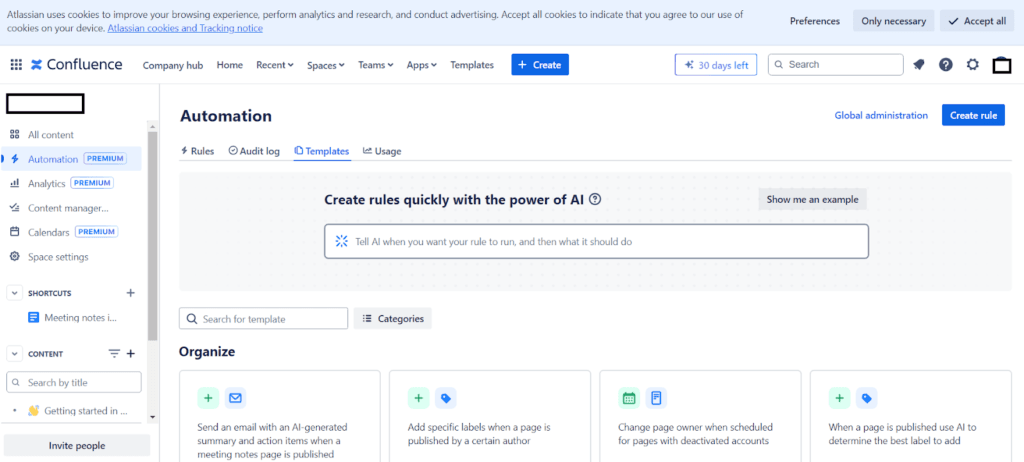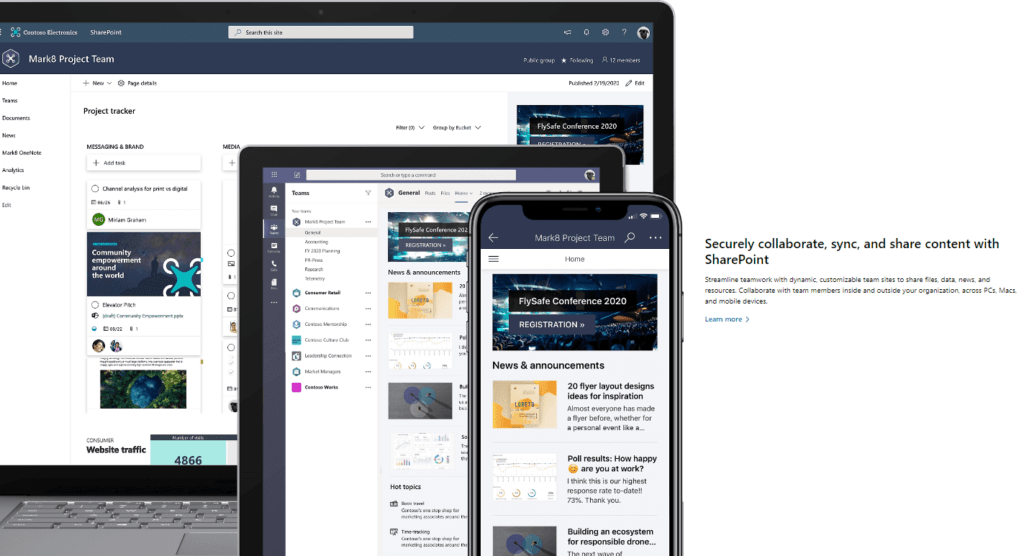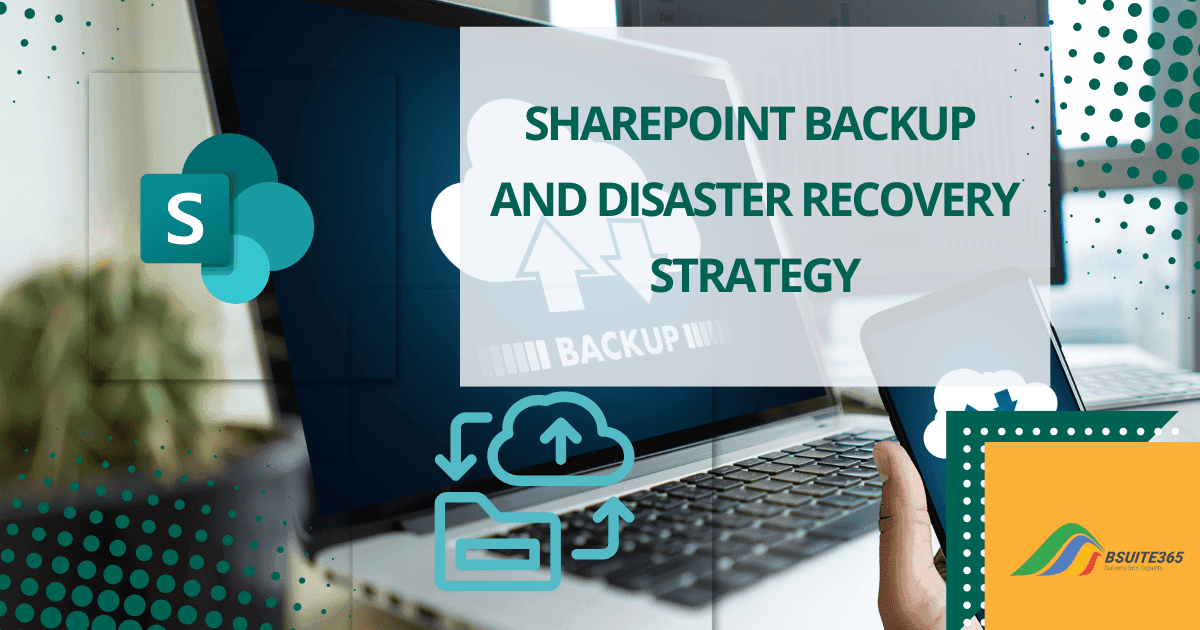Confluence vs SharePoint: Key Differences Explained
As a project manager or an individual who works in remote work environments, you know that the right collaboration tool can make or break a project. Confluence and SharePoint are two popular platforms. But what sets them apart, and which one will fit your team’s needs best?
While both platforms offer advanced capabilities for collaboration and project management, they are suitable for different needs. You can make an informed choice by comparing the features, use cases, pricing, and plans of SharePoint and Confluence.
This blog post will help you decide whether to use Confluence vs. SharePoint. We will look at their primary features and applications and compare them directly. By the end, you’ll have a clearer idea of which platform is best for your organization’s specific needs.
For businesses looking to streamline collaboration and document management, SharePoint is an excellent choice. If you’re exploring ways to optimize SharePoint for your organization, our expert SharePoint consulting services can help. We offer tailored solutions to ensure you’re making the most of SharePoint’s powerful features.
What Is Confluence?
Before comparing Confluence and SharePoint, it is important to understand what each software is and identify its features and uses. First, let’s explore what Confluence is.
In a nutshell, Confluence is a team collaboration and documentation tool, built by Atlassian. It’s designed to help teams create, share, and manage content in a central location. It is like a digital workspace where your team can keep all project documentation, ideas, and discussions.

Confluence Features
Confluence is designed to help teams create and organize knowledge efficiently. Its main features include Spaces, Pages, and Blueprints or Templates. One of the advantages of Confluence is its seamless integration with Jira and other Atlassian products, which facilitates smooth project management.
Key features of Confluence include:
- Spaces: Customized work areas for teams to organize projects effectively. Each space is tailored for specific teams or projects, serving as a central hub for all related content. This helps team members engage in discussions and collaborate on documents.
- Pages: They serve as the primary documents within spaces that can contain text and images. Pages can be linked together, creating a cohesive flow of information that is easy to navigate.
- Blueprints: They are pre-built templates that streamline the documentation process. Templates provide a structured format for common tasks, such as meeting notes or project plans. Teams can quickly start without needing to create layouts from scratch.
- Real-Time Collaboration: This allows multiple users to edit pages simultaneously, enhancing teamwork and speeding up project progress.
- Search Functionality: This allows users to quickly locate pages, spaces, and documents. This functionality is crucial for efficiency, especially in larger organizations where content can be extensive and complex.
- Content Tree: The content tree provides a hierarchical structure for organizing pages within a space. This feature simplifies navigation by allowing users to nest pages under related topics.
- Permissions and Access Control: Confluence includes fine-grained control over who can view or edit content. Administrators can set permissions at various levels, from individual pages to entire spaces.
What Is Confluence Used For?
Confluence is particularly well-suited for many aspects of project management. Here are key use cases for Confluence:
- Project Documentation: Using Confluence, teams can easily track project progress, outline objectives, and update stakeholders.
- Knowledge Base Creation: It’s a great place to build a company-wide resource for FAQs, guidelines, and more.
- Team Communication: Teams can share notes, updates, and ideas, fostering collaboration in real-time.
- Agile Project Management: It supports Agile methodologies by allowing teams to document sprint plans, retrospectives, and user stories.
- Onboarding New Employees: Managers can create onboarding documentation that includes company policies, procedures, and training materials.
- Marketing Campaign Planning: Marketing teams can brainstorm ideas, outline campaigns, and track progress on marketing initiatives.
What Is Sharepoint?
Now let’s see what SharePoint is. SharePoint, on the other hand, is Microsoft’s collaboration and document management platform. It’s been around for a while and continues to evolve, especially with its integration into the Microsoft 365 suite.

SharePoint allows teams to create Team sites and work on documents. Its Document libraries are a standout feature, offering robust file storage and management. With Lists, teams can organize data or track tasks, making SharePoint a comprehensive tool for organizing information.
Key Features of SharePoint
SharePoint is a collaboration and document management platform offered by Microsoft. It’s often used as an intranet solution and for managing documents and files. Key features of SharePoint include:
- Team Sites: Team sites in SharePoint are collaborative workspaces where teams can share files and work on documents together. They provide a centralized hub for team activities and facilitate communication among members.
- Document Libraries: Document libraries serve as centralized repositories for storing, managing, and organizing documents. They offer robust version control features that ensure teams always work on the latest document version while maintaining compliance and security.
- Lists: Customizable tools for tracking information or tasks relevant to the team. They allow users to create structured data entries that can be easily managed and updated.
- Integration with Microsoft 365: SharePoint and OneDrive seamlessly integrate with Microsoft 365 applications and other tools like Outlook and Teams. This connectivity enhances productivity by allowing users to leverage familiar tools within the SharePoint environment.
- Version Control: Version control in SharePoint ensures that all team members are working on the most current version of a document. It maintains a history of changes, allowing users to revert to previous versions if necessary.
- Customizable Permissions: SharePoint offers fine-grained access control to protect sensitive information. Administrators can set permissions at various levels to ensure appropriate access.
- Workflow Automation: SharePoint includes tools to automate business processes, improving efficiency within teams by reducing manual tasks.
These features make SharePoint a comprehensive solution for organizations looking to enhance collaboration and document management across their teams.
If you’re considering SharePoint for collaboration and document management, learn about the key differences between SharePoint and MS Teams to choose the best platform for your team’s needs.
What Is Sharepoint Used For?
Businesses use SharePoint for different purposes. It is commonly employed for the following:
- Intranet Development: SharePoint enables companies to create internal websites for employee access to news, updates, and resources.
- Document Management: This includes metadata tagging and categorization for improved organization and searchability. SharePoint’s version control ensures that teams always work on the latest document.
- Event Planning: Companies can organize events by creating dedicated sites for event details, schedules, and attendee information. SharePoint facilitates coordination among team members and keeps all event-related information in one place.
- Customer Relationship Management (CRM): Businesses use SharePoint to track customer interactions, manage leads, and store client information in a structured manner. This enhances customer service by providing teams with quick access to relevant customer data.
- Training and Development: Employers can create training modules and resources that employees can access for professional development. It supports continuous learning within the organization by providing easy access to training materials.
However, SharePoint provides many features, but users may encounter difficulties utilizing its full potential. Consulting companies like BSuite365 can help you maximize its use.
Confluence vs. SharePoint [Feature Comparison]
Confluence and SharePoint have different features. We’ll delve into their core functionalities and how they stack up against each other. Afterward, we’ll present a more detailed comparison in a table.
A. Confluence vs. SharePoint: Collaboration and Documentation
When it comes to collaboration, both platforms have strong points. However, they may have small differences:
- Confluence: Spaces in Confluence are customizable areas for team collaboration and project information storage, enabling teams to edit comments easily. These flexible “Spaces” allow teams to easily edit comments.
- SharePoint: Team Sites in SharePoint are centralized hubs for document sharing and collaboration but may offer less flexibility. It provides structured document management and offers version control for formal procedures.
As a result, if your team values open, real-time collaboration and brainstorming, Confluence may be a better fit. If structured document management and version control are priorities, SharePoint might be more suitable.
B. SharePoint vs Confluence: Organization
Both platforms provide robust document management capabilities. This can be crucial for teams handling a large volume of documents.
- Confluence: Uses Pages for documentation, which are less structured but allow for easy editing and collaboration.
- SharePoint: Employs Document Libraries, providing a more structured approach to file storage with features like version control.
Overall, if your team prioritizes open collaboration, real-time editing, and a less structured approach to document management, Confluence is a better fit. Additionally, if you require a more structured approach to document management with features like version control and robust categorization, SharePoint is a better choice.
C. Confluence vs. SharePoint: Integration and Compatibility
- Confluence: Integrates seamlessly with Jira and other Atlassian products, making it ideal for development teams. It also offers integrations with various third-party tools like Draw.io, Google Drive, ScriptRunner, Miro, Slack, Balsamiq, and more.
- SharePoint: Integrates flawlessly with Microsoft 365 applications, boosting productivity for existing Microsoft users. It also supports various integrations beyond Microsoft products.
In summary, Confluence is the preferred option for teams that already use Jira or other Atlassian tools. In contrast, SharePoint excels when utilized alongside Microsoft 365 applications. Ultimately, the decision largely depends on the tools your team is currently using.
By comparing these aspects, you can choose the best platform to meet your needs. For a more detailed comparison of Confluence and SharePoint, keep reading.
SharePoint vs Confluence [Final Verdict]
When choosing between Confluence and SharePoint, it’s essential to understand how each platform aligns with your organization’s needs. Below is a detailed comparison of their features:
| Feature | Confluence | SharePoint |
|---|---|---|
| Primary Use | Team collaboration and documentation | Document management and company-wide communication |
| Key Features | Spaces, Pages, Blueprints | Team sites, Document libraries, Lists |
| Integration | Jira, other Atlassian tools | Microsoft 365 suite (Outlook, Teams, OneDrive) |
| Search & Discoverability | Advanced search, labels, page hierarchies, home page organization, dynamic lists | Folders and sub-folders, title indexing |
| Organization | Spaces and page trees | Folders and sub-folders |
| Document Management | Simple organization with Pages and Spaces | Advanced features, including version control, metadata, and tagging |
| Best For | Small to medium-sized teams, startups | Large enterprises with structured workflows |
| Ease of Use | User-friendly, easy to set up | Steeper learning curve but integrates seamlessly with Microsoft tools |
| Customization | Highly customizable with add-ons | Extensive customization through Microsoft tools |
| Intranet Capabilities | Limited intranet functionality | Powerful intranet development |
| Pricing | Lower entry cost; free for small teams (Paid plans from $5.75/user per month) | Part of Microsoft 365 subscriptions (Paid plans for $5, $10, & $20 per user, per month; free plan for up to 10 users) |
| Ideal Scenarios | Project documentation, knowledge bases | Document management, internal websites, intranets |
| Storage | 2 GB for the free plan, 250 GB for the standard plan, and unlimited for other plans | 1 TB of OneDrive storage per user for Plan 1, unlimited for other plans |
| Mobile App | Yes | Yes |
SharePoint vs. Confluence: Pros and Cons
By considering the pros and cons of each platform, you can choose the collaboration tool that best suits your team’s needs, preferences, and budget.
Pros of Confluence:
- Flexibility and Customization: Offers extensive customization options with templates, workflows, integrations, and plugins.
- Real-Time Collaboration: Enables multiple users to edit documents concurrently, fostering teamwork and immediate feedback.
- Wide Range of Integrations: Integrates with various tools beyond Microsoft products (Jira, Slack, Trello).
- User-Friendly Interface: Easy to learn and use, making onboarding new users simpler.
Cons of Confluence:
- Limited Integration with Microsoft Products: While some integration exists, it’s not as seamless as SharePoint.
Pros of SharePoint:
- Integration with Microsoft Products: Seamlessly integrates with Microsoft 365 apps, boosting productivity for existing Microsoft users.
- Customization Options: Provides customization capabilities for site appearance and functionality based on organizational needs.
- Wide Range of Collaboration Features: Includes wikis, blogs, calendars, and other tools that support team collaboration.
- Document Management Capabilities: Offers robust document libraries for efficient storage and organization.
Cons of SharePoint:
- Complexity: This can be challenging to learn and use, especially for non-Microsoft users.
- Limited Integration with Non-Microsoft Tools: Integrations are not as comprehensive as Confluence.
- Cost: Can be more expensive due to the Microsoft 365 subscription model.
SharePoint vs. Confluence: Decision-Making Factors
Choosing between Confluence and SharePoint depends on your team’s specific needs and priorities. Consider the following factors when choosing between Confluence and SharePoint:
- Team Size: Smaller teams may prefer Confluence for its simplicity. Larger teams with complex workflows might lean towards SharePoint.
- Document Management: SharePoint’s robust document management might be essential for teams handling lots of files. If you need a centralized repository for managing large volumes of documents, SharePoint’s Document Libraries might be more suitable. Confluence is better for organizing and sharing knowledge within teams.
- Integration: Teams using Microsoft 365 will find SharePoint’s integration unbeatable. If you’re on Jira, Confluence is a natural fit.
- Budget: Confluence pricing typically has a lower entry cost, while SharePoint’s pricing depends on Microsoft 365 subscriptions.
- User Experience: SharePoint has a steeper learning curve, while Confluence is often praised for its user-friendly interface.
Are you struggling to harness the full potential of SharePoint?
bsuite365 is your trusted partner for expert SharePoint consulting services. Our team of seasoned professionals specializes in helping organizations optimize their SharePoint environments, enhance productivity, and drive business success.
Maximize Your SharePoint Investment with BSuite365
Our consultants possess in-depth knowledge of SharePoint and its capabilities, ensuring you get the most out of your investment.
Why choose bsuite365?
- Customized solutions: We tailor our services to your specific needs, providing tailored solutions that address your unique challenges.
- Proven track record: With a history of successful implementations, we deliver results that exceed expectations.
- End-to-end support: From initial assessment to ongoing maintenance, we offer comprehensive support throughout your SharePoint journey.
Our services include:
- SharePoint migration: Seamlessly transition your existing data and workflows to SharePoint.
- Customization: Adapt SharePoint to your organization’s specific requirements and processes.
- Integration: Connect SharePoint with other systems and applications to streamline operations.
- Training and support: Empower your team with the skills and knowledge needed to effectively use SharePoint.
- Governance and compliance: Establish robust governance frameworks to ensure data security and compliance.
Contact bsuite365 today to learn how our SharePoint consulting services can help your organization achieve its goals.
Conclusion on Confluence and SharePoint Comparison
According to a recent report, the global enterprise collaboration market is predicted to grow to $85.8 billion by 2026, up from $47.2 billion in 2021. This significant growth highlights the increasing importance of collaboration tools in modern organizations.
Both Confluence and SharePoint offer valuable features for team collaboration. Regardless of your choice, Confluence and SharePoint offer powerful tools to streamline workflows, improve communication, and foster teamwork within your organization.
Confluence excels in flexible, user-friendly documentation, making it ideal for small to medium-sized teams and startups. It also integrates seamlessly with Atlassian products.
Conversely, SharePoint shines in structured document management and tight integration with Microsoft 365, making it a great choice for large enterprises with complex workflows.
Our experts will be glad to help you, If this article didn’t answer your questions. ASK NOW
We believe this content can enhance our services. Yet, it’s awaiting comprehensive review. Your suggestions for improvement are invaluable. Kindly report any issue or suggestion using the “Report an issue” button below. We value your input.


